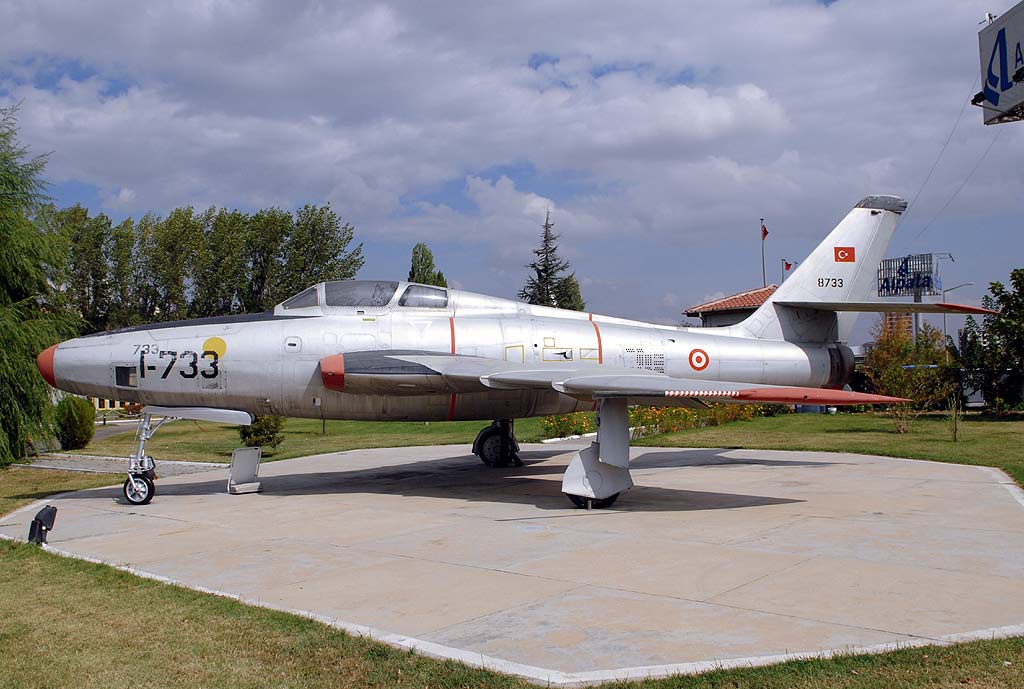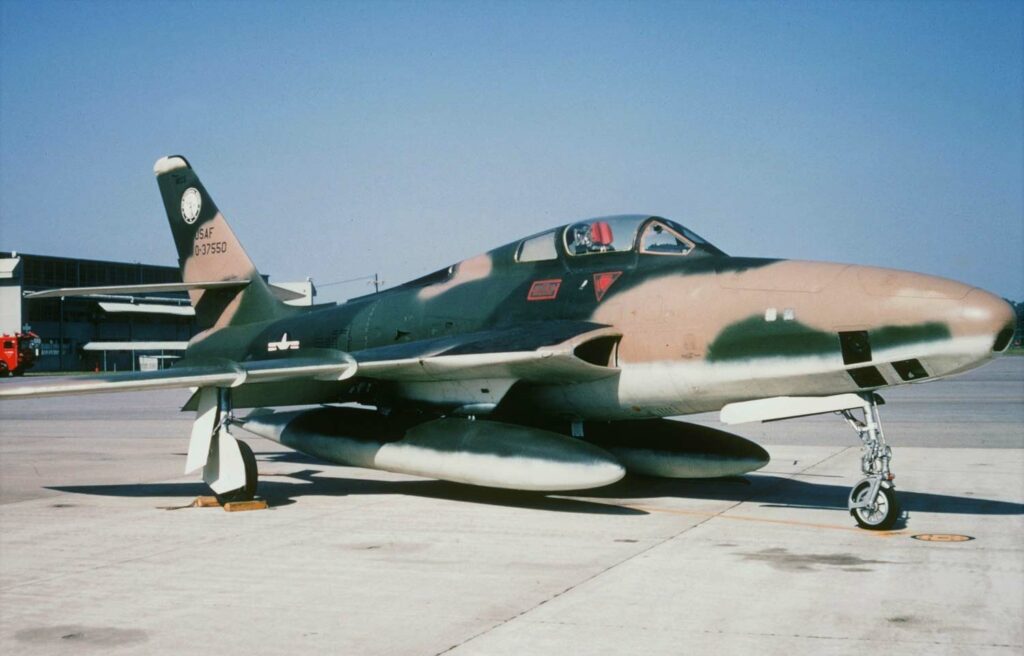RF-84 Thunderflash: Advanced recon jet, known for its high-speed capabilities and photographic reconnaissance prowess.
in brief
The Republic RF-84 Thunderflash was a high-speed, jet-powered reconnaissance aircraft renowned for its exceptional capabilities in photographic reconnaissance missions. Developed during the Cold War era, it played a crucial role in gathering intelligence and monitoring enemy activities. This article delves into the development history, design, performance, variants, military utilization, and the significant impact of the RF-84 Thunderflash in various conflicts, illustrating its pivotal role during its service life.
In the post-World War II period, the need for advanced reconnaissance aircraft capable of swiftly collecting critical intelligence on potential adversaries became increasingly apparent. The Republic RF-84 Thunderflash emerged as a response to this demand, setting the stage for its remarkable career in reconnaissance.

History of the Development of the Republic RF-84 Thunderflash
The Republic RF-84 Thunderflash was developed in the early 1950s, a time marked by the intensifying Cold War tensions between the United States and the Soviet Union. As espionage and intelligence gathering became central to national security, the need for an advanced reconnaissance aircraft capable of high-speed, low-altitude missions became evident.
Republic Aviation Corporation, led by engineer Alexander Kartveli, took on the challenge. The development program was initiated in 1950, with the objective of creating a dedicated photographic reconnaissance aircraft. The RF-84 Thunderflash program aimed to provide the United States Air Force (USAF) with a cutting-edge reconnaissance platform.
The first flight of the RF-84 Thunderflash occurred on February 28, 1951, marking a significant milestone in reconnaissance aviation. The aircraft featured several innovative design elements, including a low, straight wing with a unique split air intake design that enhanced its high-speed capabilities.
The RF-84 Thunderflash was not assigned a NATO nickname, as reconnaissance aircraft typically weren’t assigned such designations. Instead, it was recognized and celebrated for its distinctive capabilities in gathering critical intelligence through high-speed, low-level reconnaissance missions.
Design of the Republic RF-84 Thunderflash
The Republic RF-84 Thunderflash boasted a design tailored for high-speed reconnaissance missions. With a length of 47 feet (14.3 meters), a wingspan of 33 feet (10 meters), and a height of 16 feet (4.9 meters), it had a sleek and streamlined appearance. The aircraft’s empty weight was approximately 16,000 pounds (7,257 kilograms), with a maximum takeoff weight of around 36,000 pounds (16,329 kilograms).
At the heart of the RF-84 Thunderflash was its powerful Allison J35-A-35 turbojet engine, generating 5,400 pounds of thrust. This engine propelled the aircraft to an impressive maximum speed of 650 miles per hour (1,046 kilometers per hour) at sea level, making it one of the fastest reconnaissance aircraft of its time.
The Thunderflash was designed to operate at low altitudes, typically flying at around 200 feet (61 meters) above the ground. This low-level approach allowed it to avoid enemy radar detection while capturing detailed imagery of critical targets.
One of the key design features of the RF-84 Thunderflash was its innovative split air intake, located on the fuselage’s sides. This design minimized the risk of foreign object ingestion into the engine during low-level operations. However, this unique feature also posed challenges during the aircraft’s development, as it required careful engineering to ensure optimal performance.
The RF-84 Thunderflash was equipped with a range of cameras and sensors, including the K-17 camera system for high-resolution photography. Its ability to capture and relay crucial intelligence data made it an invaluable asset during the Cold War.
Performance of the Republic RF-84 Thunderflash
The RF-84 Thunderflash exhibited outstanding performance characteristics, driven by its powerful Allison J35-A-35 turbojet engine. This engine produced 5,400 pounds of thrust, providing the aircraft with exceptional speed and agility.
With a maximum speed of 650 miles per hour (1,046 kilometers per hour) at sea level, the RF-84 Thunderflash was capable of rapid reconnaissance missions, allowing it to capture critical intelligence swiftly and evade enemy threats effectively.
The aircraft’s operational altitude typically ranged from 200 feet (61 meters) to 20,000 feet (6,096 meters), enabling it to operate at low levels to avoid radar detection or climb to higher altitudes for specific missions.
In terms of range, the RF-84 Thunderflash had a combat radius of approximately 700 miles (1,126 kilometers). This range allowed it to conduct reconnaissance missions deep within enemy territory, contributing to the gathering of vital intelligence.
When compared to its contemporaries, the RF-84 Thunderflash stood out as a powerful and high-speed reconnaissance aircraft. Its low-level capabilities and speed made it a formidable asset for intelligence gathering, particularly during the Cold War.
Variants of the Republic RF-84 Thunderflash
The Republic RF-84 Thunderflash had several variants, including the RF-84F Thunderflash and the RF-84K Thunderflash. The RF-84F featured improved avionics and was widely exported to NATO countries for reconnaissance purposes. The RF-84K was a modified version designed to carry the Martin B-57 nuclear bomb and had limited operational use.

Military Use and Combat of the Republic RF-84 Thunderflash
The RF-84 Thunderflash played a pivotal role in gathering critical intelligence during the Cold War, but it was not primarily used for combat. Equipped with advanced cameras and sensors, it conducted reconnaissance missions over enemy territory, capturing imagery and data vital to national security.
Throughout the Cold War, the RF-84 Thunderflash was employed in various intelligence-gathering operations, monitoring the activities of potential adversaries. Its high-speed, low-level capabilities made it ideal for evading enemy radar while collecting essential information.
During its operational service, the RF-84 Thunderflash was not engaged in direct combat, as its primary mission was reconnaissance. However, its intelligence-gathering contributions were invaluable during numerous Cold War conflicts and crises, including the Cuban Missile Crisis and the monitoring of the Suez Crisis.
The RF-84 Thunderflash was used extensively by NATO countries for reconnaissance purposes, underscoring its importance as a reconnaissance asset in the collective defense of Western Europe.
The aircraft was eventually retired from active service as technological advancements led to the development of more sophisticated reconnaissance platforms. It was replaced by faster and more capable reconnaissance aircraft, such as the RF-101 Voodoo and the RF-4 Phantom II.
The Republic RF-84 Thunderflash, a high-speed reconnaissance aircraft, played a vital role in gathering critical intelligence during the Cold War. Its innovative design, exceptional speed, and low-level capabilities made it an invaluable asset for intelligence-gathering operations. While it was not primarily a combat aircraft, its contributions to national security and the surveillance of potential adversaries were significant. As technology advanced, the RF-84 Thunderflash was eventually retired, but its legacy endures as a symbol of Cold War reconnaissance excellence.
Back to the Fighter Jet section.